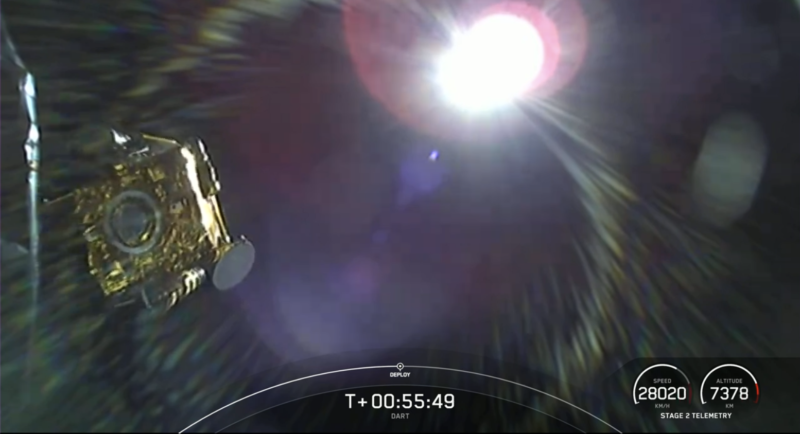
SpaceX’s personal-best-tying 26th launch of the year has roared into the night from Vandenberg Space Force Base, Calif., carrying the organization’s first mission aimed for a deep-space destination, the Double Asteroid Redirection Test (DART).
“DART is turning science fiction into science fact and is a testament to NASA’s proactivity and innovation for the benefit of all,” said NASA Administrator Bill Nelson. “In addition to all the ways NASA studies our universe and our home planet, we’re also working to protect that home, and this test will help prove out one viable way to protect our planet from a hazardous asteroid should one ever be discovered that is headed toward Earth.”
Liftoff of the three-times-flown Falcon 9 booster occurred from Vandenberg’s storied Space Launch Complex (SLC)-4E at 10:21 p.m. PST Tuesday (1:21 a.m. EST Wednesday) and the DART payload—developed jointly between NASA and the Johns Hopkins University Applied Physics Laboratory (JHU/APL)—was deployed some 55 minutes into the flight.
It will now head for a high-velocity kinetic impact with Dimorphos, the tiny companion of asteroid 65803 Didymos, in late September or early October 2022.
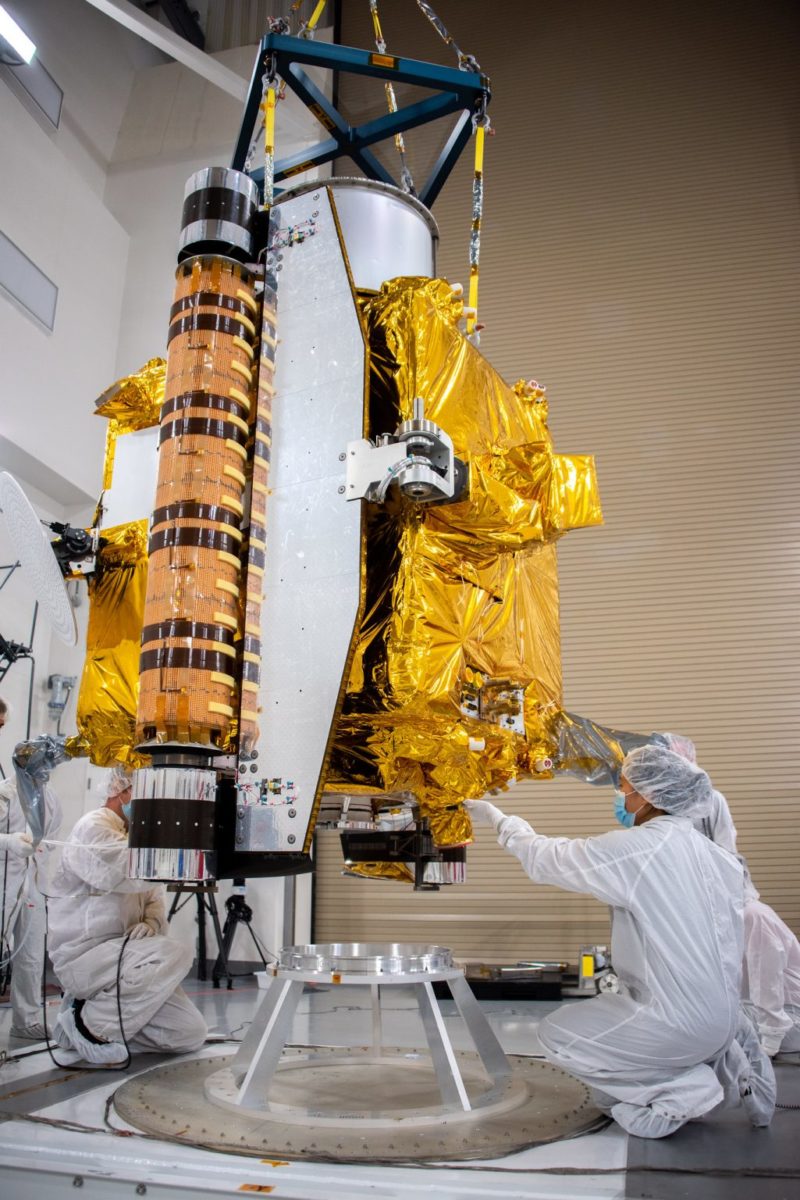
Tonight’s spectacular launch equaled with 2020 for the greatest number of Falcon 9 flights in a single calendar year. So far, SpaceX has executed 26 missions, using only nine booster cores, with two launches out of Vandenberg, ten from historic Pad 39A at the Kennedy Space Center (KSC) in Florida and the remaining 14 from Space Launch Complex (SLC)-40 at neighboring Cape Canaveral Space Force Station.
This year’s roster to date has seen 15 dedicated Starlink missions, a pair of multi-payload Transporter “rideshares” in January and June and two Cargo Dragon and two Crew Dragon flights to the International Space Station (ISS).
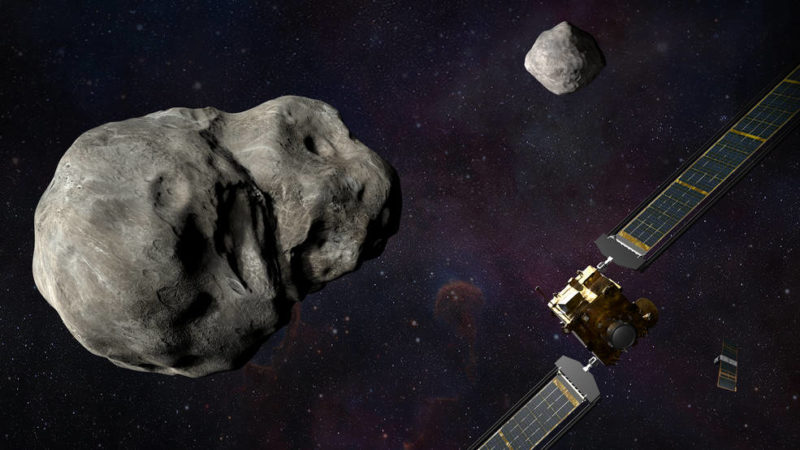
Additional launches included a pair of geostationary communications satellites for SiriusXM and the Turkish Government and last September’s historic all-civilian Inspiration4 crewed mission to low-Earth orbit.
With the flight of DART, SpaceX has also sent its first payload to a physical destination in deep space. Although it previously lofted the Deep Space Climate Observatory (DSCOVR), bound for the L1 Lagrange Point, situated some 930,000 miles (1.1 million kilometers) beyond Earth, back in February 2015, and the maiden voyage of the Falcon Heavy set Elon Musk’s cherry-red Tesla Roadster on a Mars-crossing trajectory in February 2018, DART is taking specific aim on a deep-space target: the binary asteroid system of Didymos and its small companion, Dimorphos.
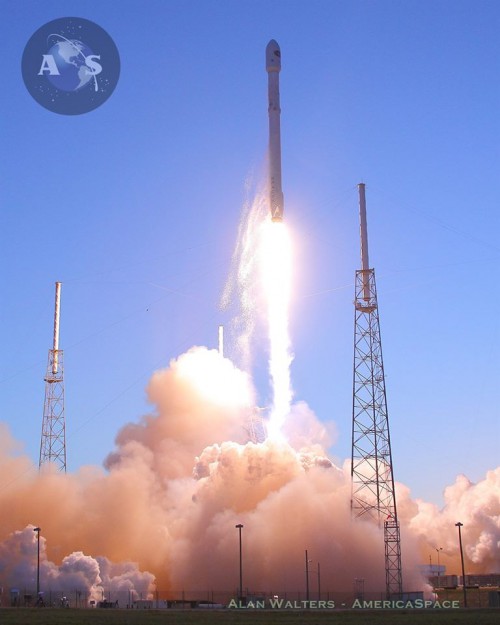
As outlined in AmericaSpace’s preview story, the 1,480-pound (670-kilogram) DART is a ten-month mission to hit Dimorphos at a velocity of about 4.1 miles per second (6.5 kilometers per second) in October 2022. It is hoped that the impact will disrupt Dimorphos sufficiently as to slow its near-circular path around Didymos by as much as ten minutes, reducing its orbital length from 11.9 hours to about 11.83 hours.
The mission seeks to evaluate the effectiveness of a kinetic impactor in altering the orbital characteristics of a Near-Earth Object (NEO) and forms an integral part of NASA’s effort to trial an asteroid “redirection” strategy to mitigate the danger posed by Earth-crossing NEOs.
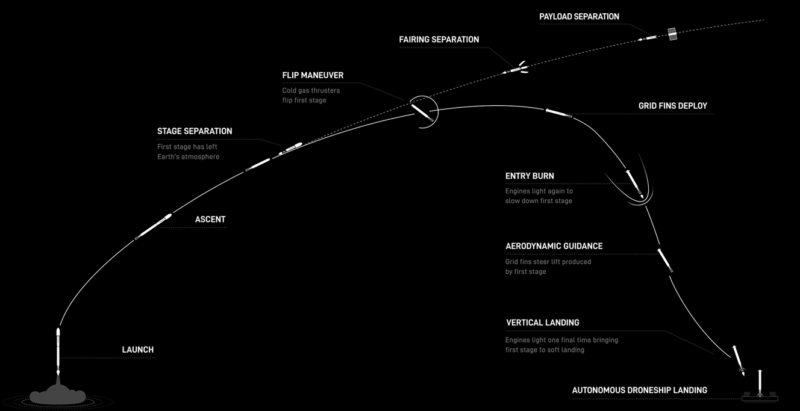
Although the Didymos/Dimorphos system does not pose a direct hazard to us, its relative closeness to Earth—it will be only 6.8 million miles (11 million kilometers) away at the point of impact, next fall—and its easy visibility makes it an ideal candidate for DART.
Didymos itself was discovered via ground-based observations using the 2.9-foot (0.9-meter) optics at Kitt Peak National Observatory (KPNO), near Tucson, Ariz., in April 1996 and its orbital parameters have been closely monitored for almost two decades; its companion Dimorphos was found in November 2003, but received its formal name only in June 2020.
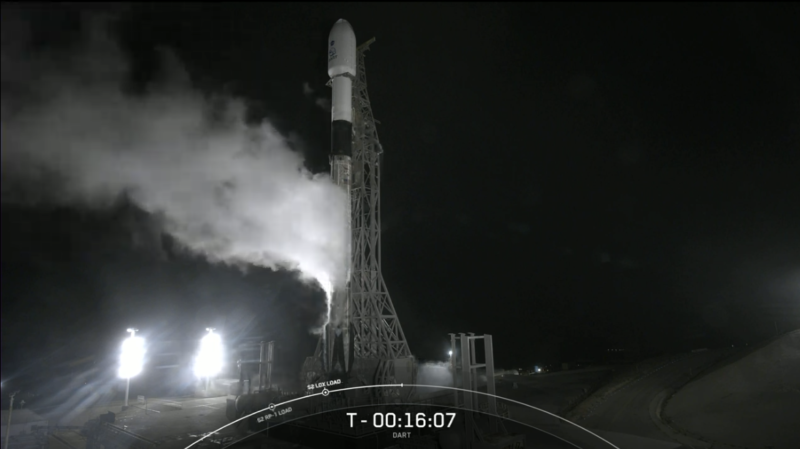
Flying tonight’s mission was the veteran B1063 core, one of few members of the Falcon 9 fleet to have alternated launches between the West and East Coasts of the United States and back again.
First launched from Vandenberg in November 2020 to place the NASA-led Sentinel-6A Michael Freilich radar-imaging oceanography payload into low-Earth orbit, it subsequently was relocated to Florida to lift 60 Starlink low-orbiting internet communications satellites last May. It was then transported back to the West Coast for tonight’s launch of DART.
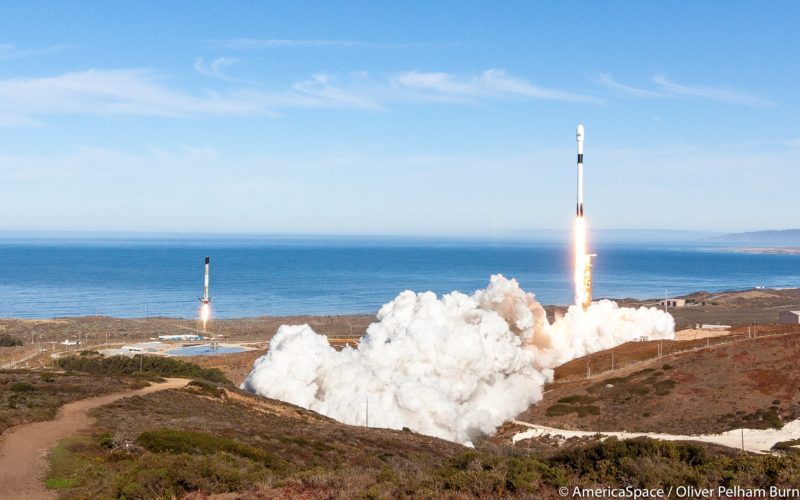
Due to the precise requirements of this mission, tonight’s launch was an “instantaneous” one, with barely a split-second available to get the Falcon 9 airborne. Had an issue interrupted the tonight’s countdown, SpaceX would have rapidly reconfigured for a backup attempt at 10:20 p.m. PST Wednesday (1:20 a.m. EST Thursday).
But the backup attempt went unneeded, thanks to a 90-percent probability of acceptable weather, winds of only 18 mph (29 km/h) and temperatures of 8.9 degrees Celsius (48 degrees Fahrenheit).
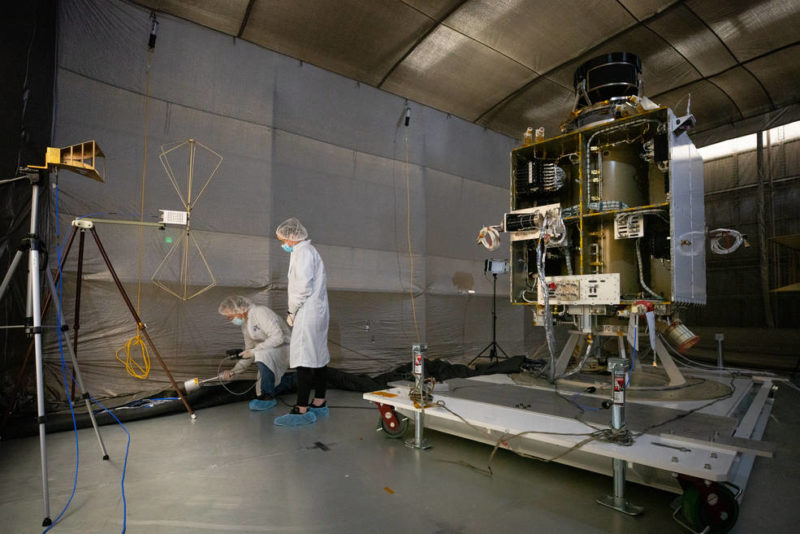
“Humanity’s first-ever planetary defense test mission,” exulted the Vandenberg launch announcer, as the Falcon 9 took flight, precisely at the start (and end) of tonight’s “instantaneous” window.
Powering uphill with a combined thrust of 1.5 million pounds (680,000 kilograms) from its nine Merlin 1D+ first-stage engines, B1063 turned night into day for Vandenberg’s second Falcon 9 launch of the year.
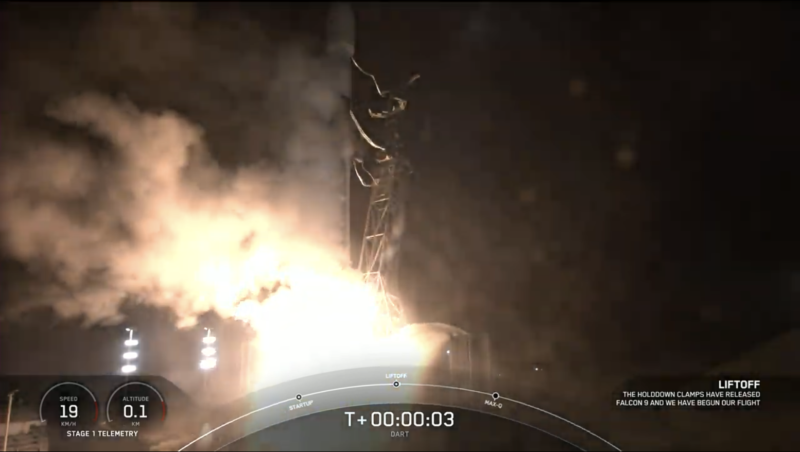
The core behaved entirely nominally, separating from the 230-foot-tall (70-meter) stack at 2.5 minutes into ascent. B1063 then completed a flawless descent to alight on the deck of the Autonomous Spaceport Drone Ship (ASDS), “Of Course I Still Love You”—the oldest active member of SpaceX’s drone ship fleet, relocated to the West Coast last summer—about eight minutes after launch.
It marked the 95th successful recovery of an orbital-class booster by SpaceX since December 2015. Now safely back on terra firma, B1063 also becomes the 12th Falcon 9 core since December 2018 to have logged as many as three launches.
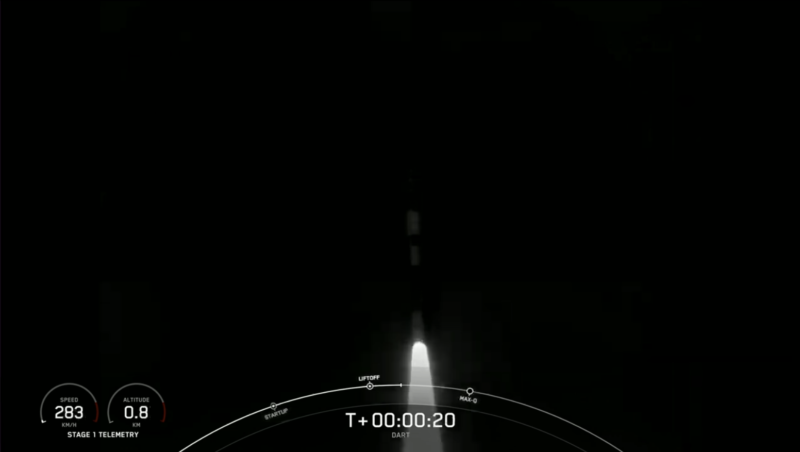
With the core stage gone, the Merlin 1D+ Vacuum engine of the second stage roared to life, glowing first red-hot, then white-hot, as it commenced a 5.5-minute “burn” to set DART on the initial leg of its ten-month trek to Didymos/Dimorphos. The engine shut down on time, a little over eight minutes after liftoff. “Second stage engine restart and escape burn complete,” tweeted SpaceX.
The remainder of the stack—its second stage and the attached DART—coasted onward for a further 20 minutes. A second Merlin 1D+ Vacuum engine firing, lasting a few seconds shy of a full minute in duration, completed the escape burn and at 11:16 p.m. PST Tuesday (2:16 a.m. EST Wednesday) the pair parted company and DART drifted off into the inky blackness, backlit by the blazing Sun.
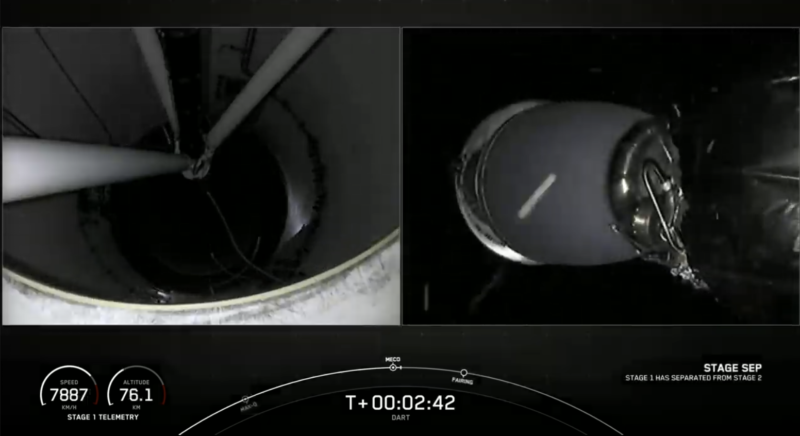
According to DART Mission Systems Engineer Elena Adams of JHU/APL, speaking at a recent press briefing, the first 30 days of the mission will be spent checking out and “commissioning” the spacecraft.
Ten days before DART reaches the Didymos/Dimorphos system, late next September, the Light Italian CubeSat for Imaging Asteroids (LICIACube), provided by the Italian Space Agency (ISA), will be deployed to fly past the asteroid. It will capture imagery of DART’s impact and its aftermath.
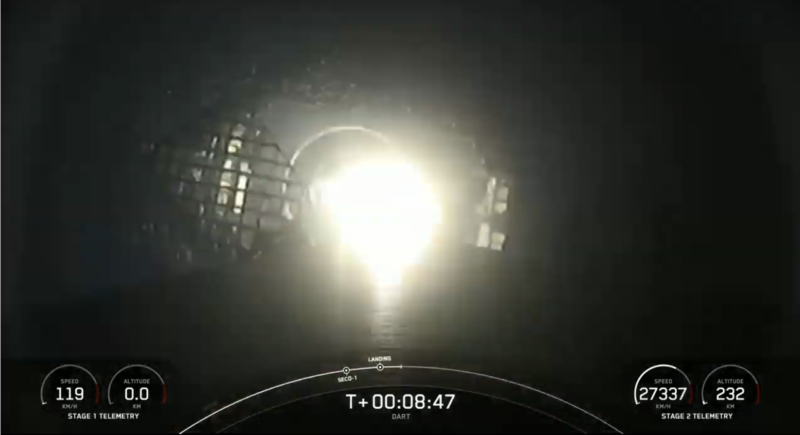
Meanwhile, DART’s primary instrument—the Didymos Reconnaissance and Asteroid Camera for Optical Navigation (DRACO)—is expected to capture imagery of the surface of Dimorphos until a couple seconds before impact, achieving resolutions as high as 1.2 inches (3 centimeters) per pixel.
Earlier in November, DART Coordination Lead Nancy Chabot of JHU/APL noted that she expects the impact will disrupt Dimorphos’ orbital duration around Didymos by at least 73 seconds and perhaps as much as ten minutes.





2 Comments
2 Pings & Trackbacks
Pingback:Record-Breaking Falcon 9 Launches, Pushes 2021’s Starlink Tally Past 900 – AmericaSpace
Pingback:SpaceX Wraps Up Second Four-Launch Month, Looks Ahead to Crewed Missions – AmericaSpace